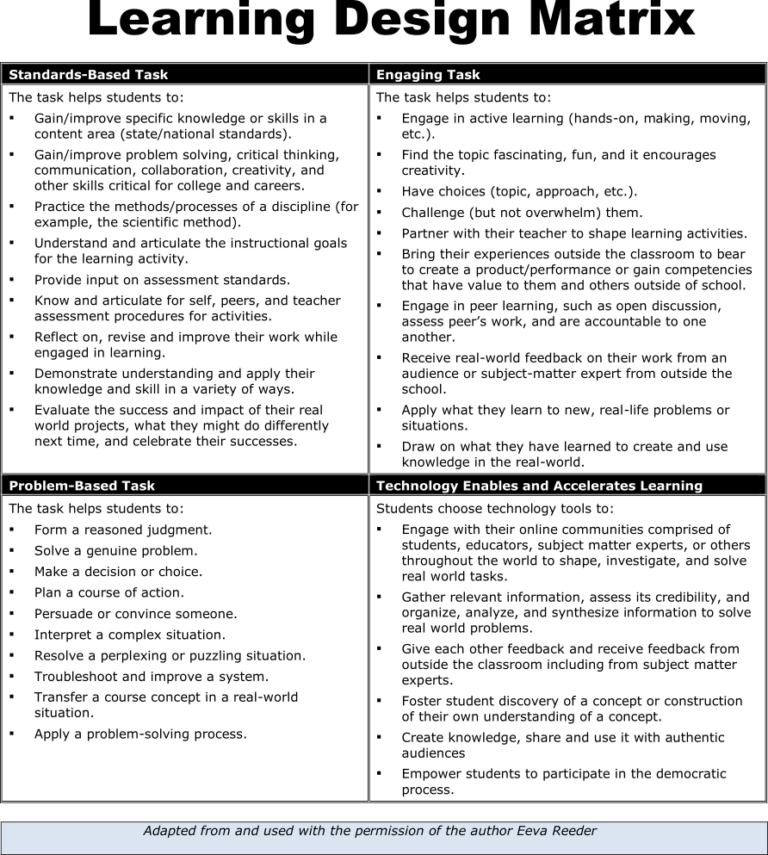
The ISTE Standards for Coaches 5a, “Design professional learning based on needs assessments and frameworks for working with adults to support their cultural, social-emotional and learning needs,” demonstrates where to start when thinking about facilitating a professional learning session. Assess the needs of the learners and select the appropriate frameworks for supporting their overall learning needs, whether, culture, social emotional, or otherwise.

Source: How to Approach Iterating Ed. Tech Professional Learning
Evidence: “With respect to the question posed above, identifying high-impact teaching and learning via research and analyzing technology with both research and frameworks allows for professional learning that addresses all of this, with respect to the schoolwide vision, to be iteratively designed. A combination of asking teachers, staying grounded in research, and formatively assessing the professional learning experiences are key. Directly asking teachers about their professional learning needs is important and a Gates Foundation report entitled Teachers Know Best: Teachers’ Views on Professional Development does exactly that. Teachers want instructional coaches and staff developers that “know what it’s like to be in their shoes”, they want well-structured collaboration opportunities, and they want choice among other things. Research backs a lot of this up as well, although, with caveats. While workshops and professional trainings are supported to a degree in research, ongoing and targeted professional learning are key which really supports instructional coaching models. Instructional coaching can be informal, formal and regular 1:1 meetings, as needed, at the instructional team or Professional Learning Community level, and/or consist of before/after school trainings as well as workshops. Per Peer Coaching : Unlocking the Power of Collaboration, “If schools want wide-scale adoption of innovative practices, teachers need a mentor or coach at each step in the process of adaptation and adoption.” The key is that the professional learning supported by the instructional coach consists of consistent and targeted learning.”
Explanation: Utilizing research instructional frameworks to assess professional learning needs for adults provides the support that adult learners want, need, and typically asked for from facilitators.

Source: PBL for the Teachers?
Evidence: “When it comes to classroom management and instruction, actively engaging learners in the learning process is important. Now, what do you envision when you think about the students in this case? Are they adults? If not then maybe they should be because teacher professional development and learning opportunities need to continue moving away from “do as I say” direct instruction to actively doing while learning. This is because Active Learning engages teachers in their own learning process so that they can better apply concepts from their own training to their own teaching.”
Explanation: Supporting adult learners’ cultural, social-emotional, and learning needs means taken into consideration all of these areas as they uniquely apply to adult learners.

Source: Puzzling Over Protocols
Evidence: “Perhaps the most well-known protocol is the Jigsaw activity. Honestly, this is with good reason, though, as The Distance Learning Playbook cites Chris Hattie’s meta-analysis work listing an effect size of 1.2 for Jigsaw as an instructional strategy. Here’s also where things become challenging as there does not appear to be standardized language across education. Whether we call these approaches protocols, learning strategies, professional learning practices, or something else, the intent is not to play with semantics but focus on the effectiveness of the approach itself. So, for our purposes, let’s consider a protocol a structured “how” for facilitating a given learning activity. Protocols don’t usually address the content directly, but they do provide a vehicle for learning the content by providing a structured activity.”
Explanation: Professional learning designed around protocols helps focus the learning on the assessed needs and instructional frameworks relevant to adult learners while providing them with immediately relevant tools for implementation in their own educational contexts.

Source: Professional Learning Can Be ‘Squirrelly’ Business
Evidence: “I read several different articles published by Edsurge and Edutopia while pondering questions I was given to consider. There were several things in common across what I read in terms of how best to improve professional learning opportunities for teachers. A major theme was making sure that training is relevant whether by surveying in advance, careful observation, addressing known needs, and/or personalizing training. Another theme was providing teachers with choice, which could be general choice of learning topics or differentiation within a specific topic. Surveying teachers in advance can help in both cases. These things can help ensure that training is engaging and even interactive which was another theme. Finally, being respectful of teachers’ time also reflects in all the themes as well as treating teachers like professionals and having the professional learning presented by someone who understands their experiences. Even the advice mentioned only once across the four articles seemed like sound options to keep in mind: sustained over time, utilize protocols, include extension activities, acknowledge teachers’ well-being, and be transparent. Additionally, all of this advice seems to apply equally well to regular teacher professional learning as well as technology-specific professional learning.”
Explanation: Relevance and choice are key components of any learning and take on an increased significance and overall importance with regard to adult learners because treating teachers as professionals in this way meets their cultural, social-emotional, and learning needs.

Source: Coaching the Coaches
Evidence: “After our initial introductory meeting, my peer coaching colleague and I arranged a follow-up meeting to focus on a possible lesson together. We looked at a relatively new project that covered six hours of professional development learning for teachers. This presented a good opportunity to practice all of the critical skills that Dr. Foltos describes as essential to successful peer coaching, “The coach’s success rests on her ability to utilize skills in all three areas: coaching skills (communication and collaboration), ICT (information and communication technology) integration, and lesson design. Remove any leg and coaching could fail.” The skills of communication and collaboration were critical in our first session as well as leading into the planning session. My job was to actively listen and verify understanding through listening strategies such as paraphrasing and summary. Once my peer coaching partner verified mutual understanding then we could focus on the collaborative act of lesson planning together. Given that the lesson instruction focused around online teaching, information and communication technology skills became a critical part of the process by the very nature of the instructional context. We maintained the focus on the learning first and foremost, and then explored a variety of technology tools to support this process. Lastly, the third facet of lesson design was certainly part of the process from beginning to end. We approached lesson design based on the collaborating teacher’s experience, and kept this in mind as this would drive a lot of the reflection process.”
Explanation: Being able to design professional learning depends on an educator’s coaching skills, information and communication technology integration ability, and understanding of lesson design. Mastery of these skills allow a coach to effectively assess needs and apply educational frameworks while taking into consideration the cultural, social-emotional, and learning needs of adult learners.

Evidence: “Teaching is a hard job and, by association, so is peer coaching, “Most Peer Coaches I have worked with know that they are trying to build these kinds of relationships in difficult circumstances. Many have worked in schools in which teachers work alone and in which collaboration consisted of teachers exchanging lesson plans and teaching resources,” (Foltos, 2013). Building relationships is key to being able to make any progress with regard to effective coaching translating into student learning growth. True collaboration is elusive because school systems are not designed to facilitate this. So coaches must rely on relationship to bridge these systemic gaps, “Being friendly, positive, and supportive doesn’t guarantee innovation, but coaches won’t encourage innovation without drawing on these behaviors to create a safety net.” To influence teachers, coaches need to be adept and adroit with their approaches to create that trust-based safety net so that they can “Arouse in the other person an eager want” and “Make the other person happy about doing the thing you suggest,” (Carnegie, 1936). Creating a safe enough environment for positive change to happen is more challenging with teaching because it’s deeply personal, “Teaching is an identity and an action, not just a vocation,” (Fisher, Frey, Hattie, 2020). This means that, ultimately, “Peer Coaches can’t be the experts with the answers. Instead, as Grace Dublin insists, coaches are there to “help them formulate their strategies. It is ultimately their answer” (G. Dublin, personal communication, September 13, 2011),” (Foltos, 2013). Coaches can truly effect change by believing in their teachers to arrive at their own answers because belief not only has a large effect size on learning, but it also does something even more powerful: it empowers the believer to “Give the other person a fine reputation to to live up to,” (Carnegie, 1936). This action persuades teachers to pursue the desired improvement by way of self-fulfilling prophesy because a coach knew that a teacher could be something more and guided them to that realization through careful facilitation, collaboration, and expertise that all lead up to a catalyst.”
Explanation: Building relationships allows a coach to better understand the cultural and social emotional needs that teachers may have because those needs can become evident through the establishment of the relationship itself. Since teaching is such a personal profession, understanding educators through the lens of relationship helps a coach to better assess learning needs as well as the appropriate instructional frameworks for addressing those needs.

